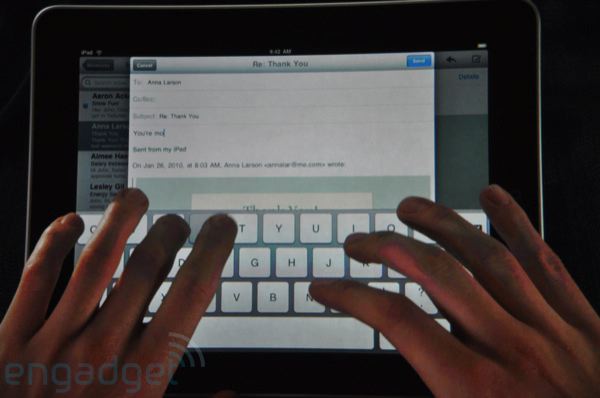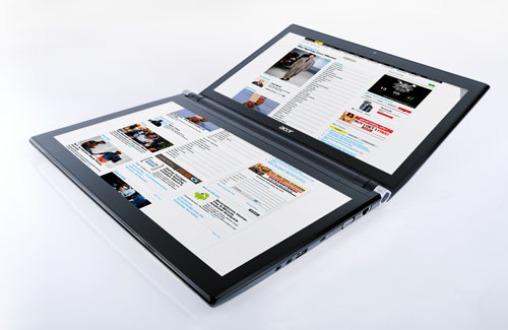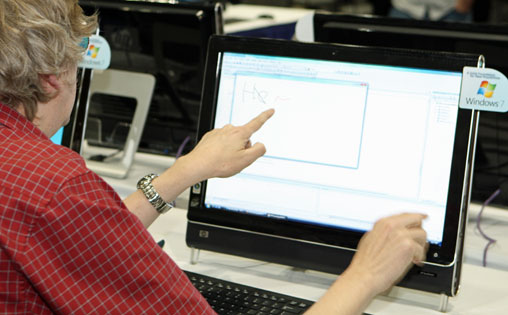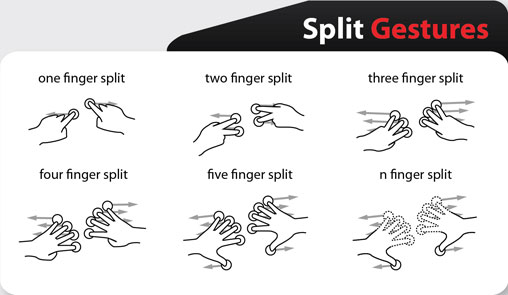Display technology of the year: Multitouch (1)
TipsMake.com - Touch screen panel has been around for over a decade, but it wasn't until 2007 that the launch of multitouch screen (multi-touch) on Apple iPhone brought a market New wind. Now multitouch technology is becoming the focus of the market as an advanced touch screen technology that manufacturers hope to build on Apple's success.
 Display technology of the year: Multitouch (1) Picture 1
Display technology of the year: Multitouch (1) Picture 1
Multitouch technology is currently booming with sales of up to $ 6 billion for manufacturers this year, with more than 200 suppliers competing fiercely - and it will increase to more than $ 13 billion by the year. 2016, according to market research firm DisplaySearch. "It has been a very large market, and is growing fast, " said analyst Jennifer Colegrove.
Current multitouch technology dominates the smartphone market, and with the launch of the iPad in 2010, the technology is kicking off to continue attacking the tablet market. The technology is also entering many other devices from large desktop screens to in-flight entertainment systems found in seatbacks of commercial passenger aircraft - and beyond.
A 'light touch' rather than a 'push'
Before the iPhone , most touch screens use pressure recognition technology, resistive touch screens require users to have physical effects such as pressing down on the screen. Resistive screen can only track the position of one finger at a time.
Apple has chosen a competitive technology: capacitive technology, which helps the screen react to a light touch, it can sense your finger when you touch an electric field above the surface. Touch face - a technique called distance perception. The control panel is at the top of the display screen (most commonly a liquid crystal display). Capacitive touch technology is designed so that our fingers (or a capacitive stylus are specially designed) to disturb the electric field, unlike the resistor design, it will not work with a normal pen or other senseless object.
Capacitive screen projects use a glass touch surface to make the screen more transparent than the plastic used in resistive technology, resulting in brighter colors. Glass touch surfaces are also more durable, and capacitive technology also limits the surface scratches.
Apple's breakthrough with the iPhone version 1 has opened up a new trend of touch screen use, which is to use as many "touches" as one time, as before, allowing Develop iPhone gestures that have now become familiar such as: scanning on the screen, rotating and narrowing / expanding. "That's really the way touch screens can be used," said Bruce Gaunt, a mechanical engineer at Product Development Technologies, a company that designs and integrates touch screen technology for Mobile phone manufacturers and laptops said. "That's what Apple did very well."
Recently, Samsung has integrated successful multitouch technology into active light-emitting diode matrix (AMOLED) screens in devices such as Galaxy S. Smart Super AMOLED technology, location sensor technology. Allows the screen to sense the effects of the finger instead of requiring a separate layer to make the design of the screen thinner.
" Samsung is a pioneer in bringing sensors into OLED matrix displays, " said Vinita Jakhanwal, an analyst with market research firm iSuppli.
Popular and limited
This year, the smartphone market will reach a crossover point, with more than 50% of units including capacitive touch screens and OLED touch screens, said Jakhanwal. Tablets are also a fast growing market with multitouch technology that demonstrates the success of Apple's iPad product line, not to mention the introduction of a series of other tablets announced this year at Fair consumer electronics goods.
Previously, laptops with dual-touch multi-touch screens would appear, with Acer's Iconia notebook at the forefront, expected to ship in the first half of this year. This design replaces physical keyboards with a second display surface that can be used as a virtual keyboard or as an extended screen.
 Display technology of the year: Multitouch (1) Picture 2
Display technology of the year: Multitouch (1) Picture 2
Acer Iconia laptop is still in the process of being completed with the multi-touch touch screen feature integrated in two.
This device has a starter button on the side, designed like a book to display two pages of a text one by one, and users can flip pages using a gesture, just like when they read on iPad .
But creating a larger touch screen is a challenge, said Ken Bosley, software product manager for destop global business unit for consumers of HP. Because production of capacitive technology is very expensive with larger screens than the screen of a tablet. HP uses an optical multi-touch technology, which has two cameras mounted on the edge of the touch screen that define the coordinates for its TouchSmart desktop and laptop lines.
" There are a lot of durability issues with touch screens ." Bosley said. " And while Apple integrates multi-touch technology with its operating system, Windows support must still be used ." Windows 7 is not suitable for touch, so we have to work a lot with our touch software.
Because integrating a multi-touch technology into a desktop computer will cost an additional $ 150 more than the desktop price in general, Bosley said, and because it is still viewed as a additionally, or an alternative to keyboards and mice, some argue that multistage technology is causing waste of money. A resistive touch screen will allow you to perform basic features such as starting playing a DVD. The problem, Bosley said, is that users now expect all touchscreen devices to support multi-touch, whether it's a beneficial technology or not. " If you don't meet consumer expectations, they will turn away ."
A good example: TouchSmart provides an on-screen keyboard, although most people never use it. People like to use regular keyboards, Bosley said, "but we still integrate it because people expect it ."
Michael Woolstrom, CEO of touch screen maker Touch International, agrees. His company is working with business partners to provide seatback multi-touch screens to replace the current generation of touch-sensitive resistors on the touchscreen that recognize pressure in Airbus passenger aircraft at the end. this year. " Users want to have scanned, narrowed, expanded screens, " he said. " Multitouch gives them that feeling ."
 Display technology of the year: Multitouch (1) Picture 3
Display technology of the year: Multitouch (1) Picture 3
A big problem with vertical touch screens is the 'gorilla arm' effect, said Andrew Hsu, a strategic maker of Synaptics touch screen technology. work sustainably with arms extended out - it creates a sense of strangeness and fatigue.
On the TouchSmart, HP has somewhat improved this problem by allowing users to use the display tilting back 30 degrees vertically. That will help improve somewhat, but Bosley admits that using the touch screen in that angle still creates a sense of embarrassment. HP's user activity studies show that users tend to tilt the display depending on the application, he said. For example, with Solitaire application, users will tilt the display back, pull it close and use the touch screen, but they tend to not use the on-screen keyboard and in this way, no The place for the arm you can rest, it creates a very uncomfortable feeling.
But on smartphones and tablets, this is not a big problem. Users are more likely to take full advantage of the touch capabilities and use the virtual keyboard.
There will be more gestures for users
Multi-touch system designers are hoping to expand the gesture system to create new sensations when used by top users, Apple. Synaptics is an example, offering a Scrybe gesture set that allows designers to choose from a common library of gestures and create a few customizations of their own.
" You can, for example, default to a gesture to get you right into Amazon.com to buy a product ," Hsu said. Scrybe is currently marketed only for touchpad laptops, but Synaptics says the technology can be expanded on touch screens.
Swype provides a set of gestures for Android and another device platform that allows users to type letters by sliding their finger on a virtual keyboard instead of clicking on it. And GestureWorks' open source gesture library provides more than 200 multi-touch gestures for Flash and Flex developers.
Apple is also working to expand its gesture.IPad makers are testing new touch functions that support up to five fingers in a beta version of iOS 4.3 - although the company has announced that it has no intention of producing multi-screen displays. Vertical touch on desktop or laptop.
 Display technology of the year: Multitouch (1) Picture 4
Display technology of the year: Multitouch (1) Picture 4
But those are not standard platforms, and Mr. Bosley thinks the new gestures are less popular and less intuitive than the three common basic gestures that Apple has brought. " I saw a recent Apple patent, and it looks like American sign language. Why do people want to learn a new language? " He asked. " People will use standard, intuitive gestures on the screen. I don't think they will be ready to learn a new set of gestures like that ."
Mike McSherry, Swype's chief executive, also agreed. " It would be unrealistic to expect that universal users learn more than a few basic gestures ," he said. He said that these gestures will continue to be used primarily for application launches, orientation or some similar features.
Three-dimensional
The sensibility of capacitive touch screen technology makes it possible to detect motion not only on the X-axis and Y-axis of the screen surface, but also on the Z axis. In the future, proximity sensors can bring touch screens into three dimensions - if touch screen manufacturers can figure out how to apply it.
This technology has the potential to not only decipher the proximity of a finger, but also decode gestures that the fingers create. For example, when a user extracts his or her fingers outwards, the touch screen can decode it as a command to enlarge the image on the screen.
" We can feel very, very small changes in the capacitive environment, and because of this, we can clearly feel the gestures of your hand, " said Trevor Davis, marketing director. For Cypress Semiconductor touch screen, however, decoding other subtle gestures is still a challenge.
On the one hand, simple applications like " hover sensor " have been used, such as a smartphone screen that turns off when you keep it close to your ear, or LED buttons will light up. Dell SP2009W screen touch screen only when the user's hand touches the screen. But detecting the presence of a finger on the screen is the easy part.
" The biggest problem is trying to decipher the user's intent ," said Hsu. Even in an application context, if we do not have the ability to decipher the user's will, it will lead to application capabilities challenges. "
However, R & D currently has the idea of using sensors almost as a user interface, especially in automotive control systems, said Jérémie Bouchaud, an analyst with iSuppli. Developers working on 3D gestures will allow users to zoom or move the map and will lift the contents of the screen side to side with a waving hand. The system can also distinguish whether the hand that performs the action is that of the driver or the passenger, preventing the system from responding to driver gestures for safety reasons.
And for larger touch screens that use optics instead of capacitance, researchers are working on 3D optical touch technology to detect motion within 50 cm of the screen. " This system is expected to appear within two years, " Bouchaud said.
Proximity sensors also have another benefit besides exploiting gestures. Mr. Davis took for example the smartphone manufacturers can use proximity sensors to determine if a device is being placed on the table, in your hand or on your lap, to adjust the level of sound. or fan system accordingly.
Outside of traditional computing devices
No matter how gesture-based multi-touch development, one thing is clear: the multi-touch screen will continue to grow beyond the range of smartphones and tablets into one. wide range of computers and other consumer electronic products that people interact every day.
Multi-touch controls have been integrated into high-end cameras, cars and even household appliances, said iSuppli analyst Rhoda Alexander, and will gradually expand into lower-end models. . She said multi-touch may not be integrated into a large television screen, but remote controls with power buttons will start giving way to multi-touch controllers and multi-touch applications running on Smart phones, such as the L5 remote control for iPhone.
" We really only see its original part at this time." "As we move forward, you will see all kinds of traditional electrical equipment that have been using touch screens, especially multi-touch ".
You should read it
- Apple will death 3D Touch on iPhone?
- Time of multi-touch
- Useful shortcuts on iPhone with 3D Touch without your knowledge
- Collection of multi-touch screen laptops
- Battalion Multi-Touch CZ-10: Multi-touch technology encroaches on laptops
- Dell introduces new Studio series, multi-touch screen
- Why the touch screen does not work and how to fix it
- Close up laptop multitouch screen
- iOS 11.3 disables iPhone touch screen being replaced by 3rd party
- Control Apple TV remotely with iPad, iPhone or iPod Touch
- TouchSmart TX2 touch screen rotation
- Open HP multitouch laptop box






 Acer's first multitouch notebook
Acer's first multitouch notebook Open HP multitouch laptop box
Open HP multitouch laptop box The era of TV 8K is coming, what do you know about 8K technology?
The era of TV 8K is coming, what do you know about 8K technology? The most fascinating and odd technology stories of 2018
The most fascinating and odd technology stories of 2018 How to present the tray to offer over the gift of fortune for the whole year
How to present the tray to offer over the gift of fortune for the whole year Prayers for all Year-end New Year's Eve at the end of the year
Prayers for all Year-end New Year's Eve at the end of the year